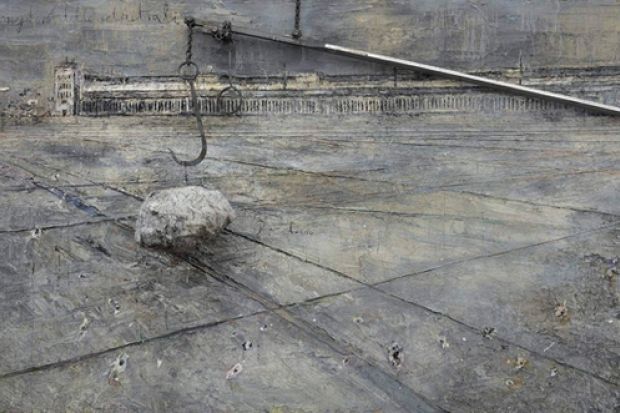Anselm Kiefer: Il Mistero delle Cattedrali
White Cube gallery, Bermondsey, London, until 26 February
Anselm Kiefer's Hortus Philosophorum seems to be a pile of uprooted mutant sunflowers. They are made of lead, although some are stained rusty brown. A brown terracotta snake is hidden beneath them. Slung over them is a set of vast books, also made of lead, greenish with oxidisation, which looks like mould.
Il Mistero delle Cattedrali is a huge canvas thick with swirling layers of paint. In the lower half, the dominant shades are grey, brown and a luminous sickly green, so the effect is like a blasted landscape or diseased flesh. But as one moves upwards it slowly turns into a lyrical mountain scene. In front hangs an alchemist's balance for transforming base metal into gold.
Other paintings focus on Tempelhof Airport in Berlin, built on land once belonging to the Knights Templar, which was planned as a great showpiece of Nazi power. Kiefer shows us the vast deserted hangars and, in one case, suspends some of his weird inverted sunflowers in front of them. Tiny toy-like lead planes are attached or scattered on the floor, in sharp mockery of military pretension.
This is said to be the largest-ever Kiefer exhibition in London, with 20 works taking over 11,000 square feet of the new White Cube gallery in Bermondsey. He has been a controversial figure since the 1960s, when he launched his career with a series of photographs of himself performing the Nazi salute, illegal in his native Germany. He has devoted much of his subsequent career to exploring, challenging and neutralising the imagery of the Third Reich.
Admirers praise him for confronting the deepest and darkest national taboos. Critics call him grandiose, claim that he is rather too fascinated with the regime that ended in the year of his birth or suggest that his interest in alchemy reflects a somewhat dubious desire to transform the base metal of Nazism into something beautiful. This powerful and typically ambitious show does much to answer such accusations.
Kiefer undoubtedly has a number of recurrent motifs, from primeval forests and Wagnerian mythology to Jewish mysticism. But his astonishing ability to instil his public themes with personal passion means that he seldom feels repetitive. His landscapes are always specific individual places even though, as one moves closer, they invariably also appear like battlefields or scenes of a post-nuclear apocalypse. The menace and horror seem organic rather than imposed from outside by using hand-me-down symbolism.
It is unsurprising that Kiefer has inspired a minor academic industry and it is certainly illuminating to read about the complex webs of allusion he often incorporates. This superb exhibition vividly confirms that, for all his intellectualism, he is also an artist of raw and disconcerting emotional power.
